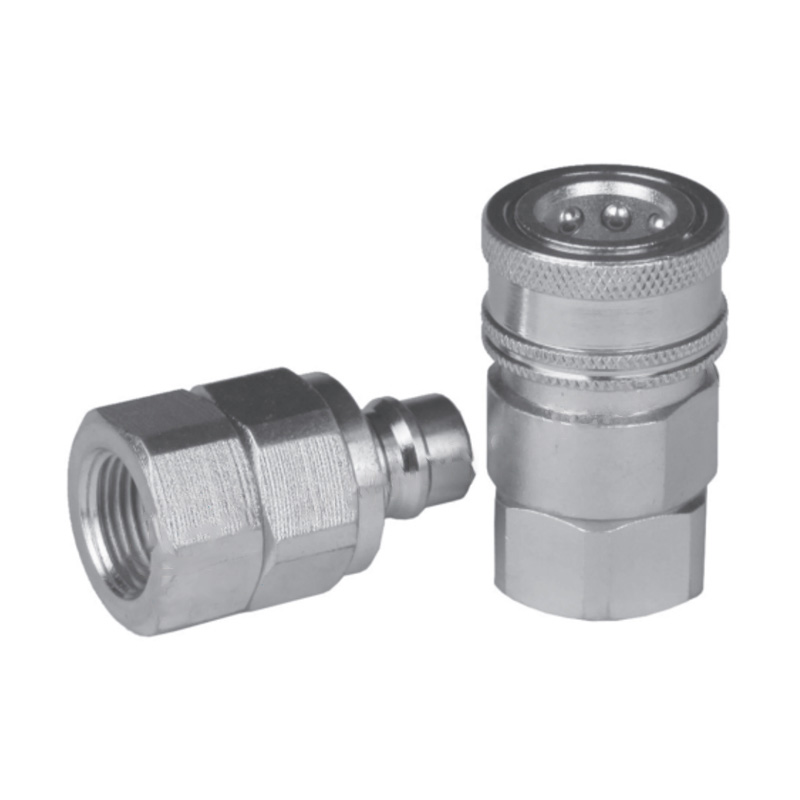Call us
+86-13732136622
+86-15058221666

Inspect O-Rings: O-rings are pivotal components in quick couplers, responsible for creating a reliable seal between the male and female halves. Before each use, conduct a thorough visual inspection of the O-rings. Look for any signs of wear, such as cuts, nicks, abrasions, or flattening, which can compromise their sealing capability. Replace O-rings immediately if they show any damage or deterioration. It's crucial to ensure that O-rings are clean and free from contaminants like dirt, dust, or old hydraulic fluid residues, as these can impair the seal and lead to leaks. Use a clean, lint-free cloth dampened with a mild solvent to carefully clean the O-rings and mating surfaces of the quick coupler. Once cleaned, allow the surfaces to dry completely to prevent any residual solvent from affecting the seal.
Clean Surfaces: The cleanliness of mating surfaces directly impacts the effectiveness of the seal. Prior to connecting the quick coupler, meticulously clean both the male and female halves. Use a solvent appropriate for the application to remove any dirt, grease, or debris that could interfere with the sealing process. Ensure all cleaning agents are thoroughly removed and surfaces are completely dry before attempting to connect the coupler. Even small particles or contaminants can cause O-ring damage or prevent a tight seal, leading to potential leaks and operational inefficiencies.
Align and Connect Properly: Correct alignment is critical when connecting quick couplers to prevent damage to the O-rings and ensure a secure, leak-free seal. Align the male and female halves carefully to avoid any misalignment that could cause O-ring damage or prevent proper engagement. Apply axial force evenly and steadily during connection to ensure a smooth mating process without forcing or jamming. Avoid any twisting or lateral movements that could stress the O-rings or cause misalignment, as these actions may compromise the seal integrity. Proper alignment and controlled force application are essential to achieving a reliable hydraulic seal with quick couplers.
Apply Proper Force: When connecting quick couplers, apply the appropriate amount of axial force needed to achieve a secure connection. The force applied should be sufficient to seat the O-rings properly and create a tight seal, but not excessive to the point of damaging the seals or components. Follow manufacturer recommendations regarding the amount of force required for connection to ensure optimal sealing performance. Applying too much force can lead to O-ring deformation, cutting, or extrusion, which compromises their ability to maintain a seal under pressure. Conversely, insufficient force may result in a loose connection or inadequate sealing, leading to leaks and potential system issues.
Regular Inspection and Maintenance: Implement a proactive inspection and maintenance program for quick couplers and associated O-rings to ensure ongoing reliability and performance. Conduct routine inspections to assess the condition of O-rings, checking for wear, damage, or signs of deterioration. Replace O-rings at recommended intervals or as part of scheduled maintenance to prevent unexpected failures and minimize downtime. Keep detailed records of maintenance activities, including O-ring replacements and inspection results, to track component performance and identify any emerging issues early. By staying proactive with maintenance, you can extend the service life of O-rings and optimize the sealing efficiency of quick couplers in your hydraulic system.
GT-TNV Close type hydraulic quick coupling


The GT-A2 closed-type thread locked hydraulic quick connect coupling sets are a type of hydraulic coupling used to quickly and easily connect and disc...
See Details
GT-C1 ball valve type hydraulic quick coupling is a type of hydraulic coupling used in fluid power applications to quickly connect and disconnect hydr...
See Details
● GT- FF Series couplings employ flush valving when connecting or disco nnecting.This means that the valves are mated together so that only small am...
See Details
The GT-1141 is a type of hydraulic quick coupling that is commonly used in fluid transfer systems. It features a brass thread locking sleeve and a sta...
See Details
The GT-VVS Steel thread locked type chrome plating hydraulic quick coupling is a type of hydraulic coupling used in hydraulic systems. These couplings...
See Details
● The smooth, open bore with no valving in either half offers minimal pressure drop and allows easy cleaning in applications where the same lines are...
See Details
Applicable for the connectors between equipment of hydraulic pipe in superhigh pressure separate type.
See Details
Material: Carbon Steel Plating: Chrome Plated Temperature Range (Nbr): -20°C + 100°C Thread Size: Dn10 Dn12.5 Dn20 Dn25 Dn31.5 Thread: M18*1.5 M22*1....
See Details
GT-MA High flow brass quick coupling mould is a type of mold used in the manufacturing of high-quality brass quick couplings. This type of mold is typ...
See Details
The GT-MB low-temperature resistance brass quick coupling mould is a type of mold used in the production of brass quick couplings for low-temperature ...
See Details
Contact Us